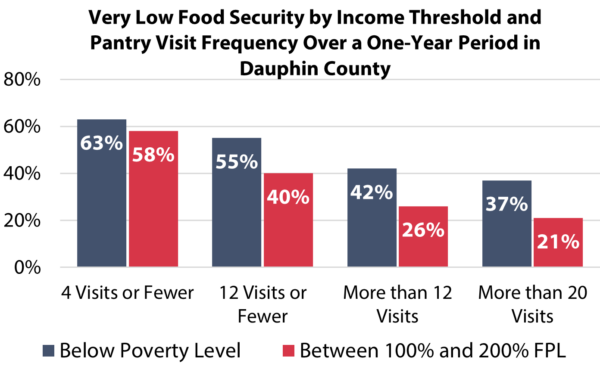By Morgan Flood, Policy Research Specialist
and Zach Zook, VP/Director of Impact and Policy
On February 27, the Central Pennsylvania Food Bank’s Impact and Policy Research will launch and present the Dauphin County Community Hunger Mapping Report, an eighteen-month project to learn more about food insecurity’s impact on the nearly 300,000 people who call Dauphin County home. This policy blog previews a simple, yet powerful finding discussed in the final report: food pantries dramatically reduce experiences of hunger in our communities. Additionally, there are opportunities to make the charitable food system an even more effective means of preventing hunger.
Analysis of neighbor surveys conducted as part of the project indicates that food pantries in Dauphin County have a major impact on the food security status of the people it serves and that the impact increases with each visit. Specifically, Dauphin County households who visit food pantries more frequently are less likely to experience very low food security, the most severe form of food security. Households facing very low food security often skip meals because they lack money for food. Therefore, these findings show that food banks and food pantries’ efforts make a meaningful difference for the people they serve by preventing them from having to make that difficult choice.
Very low food security rates for households below the poverty line are 33% lower among those who visit a food pantry more than twelve times (about once a month) compared to those who visit four times or fewer, as shown in the graph at right. For neighbors who visit approximately twice a month (more than 20 times in a year), very low food security rates are 40% lower. This pattern holds for households with incomes above the federal poverty line; very low food security rates are 55% lower for these households if they visit more than twelve times a year and 64% lower if they visit 20 times or more.

As powerful as food pantries are to combat food insecurity, there is a significant geographic disparity in their effects. Further analysis shows that pantries in Harrisburg reduce food insecurity by less than pantries in suburban or rural parts of the county. This finding reflects the depth and breadth of food insecurity in Harrisburg. Very low food security is directly correlated with poverty, and the poverty rate among pantry visitors in the city is nearly twice that of pantry visitors elsewhere in the county (75% compared to between 30% and 40%).
These findings reveal that the charitable food system is an extremely valuable support to neighbors at risk of hunger and is meeting its main mission of alleviating food insecurity. However, more can be done to maximize the charitable food network’s impact. To ensure that neighbors have access to all the food they need, pantries should collaborate to ensure that visitors can receive at least two services from the same pantry or visit at least two different pantries within a month and work to promote other programs that can prevent or alleviate hunger, such as SNAP and WIC.
Addressing food insecurity requires a strong collective response from the broader community as well. Stakeholders, such as donors and government entities, should make targeted investments in the city of Harrisburg, since it faces a disproportionate challenge in fighting food insecurity that requires a commensurate response, while also continuing to support the charitable food network’s efforts across Dauphin County at large.
The full report and launch event feature much more analysis and many more recommendations that can help food pantries, food banks, and other anti-hunger and anti-poverty organizations ensure that their work is making the biggest difference for the most neighbors at risk of food insecurity. To learn more, please join us at our launch event, which will be held on Thursday, February 27 at 1:30 PM at Commonwealth Charter Academy in Harrisburg. For those who cannot attend in person, the event will be accessible virtually via Zoom.
